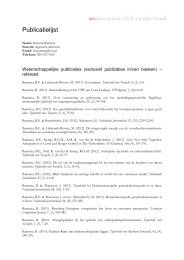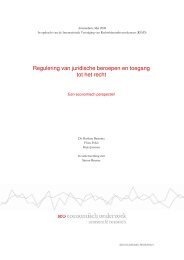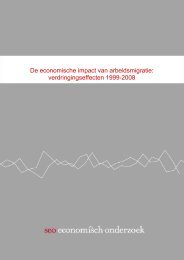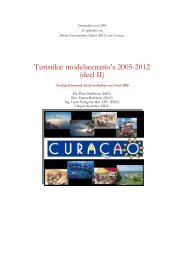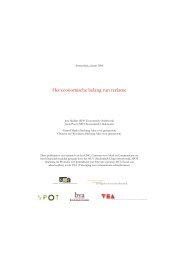Amsterdam, Netherlands - SEO Economisch Onderzoek
Amsterdam, Netherlands - SEO Economisch Onderzoek
Amsterdam, Netherlands - SEO Economisch Onderzoek
Create successful ePaper yourself
Turn your PDF publications into a flip-book with our unique Google optimized e-Paper software.
mobility in the world is slackening due to trade blocks and an unfavorable international climatefor unrestricted global capitalism. The clear focus of the joint regional innovation strategy helpsthe HEIs to meet the regional demand for their services.For the labor market regional communities implies a moderated skill biased growth. This meansthat the risk of a divided labor market is lower. Social problems such as the high unemploymentrate at the lower end of the labor market call for an activist approach by the regional authorities.This will probably mean increased public investment in active labor market policies. Extrainvestment in education and schooling is part of this approach. The HEIs will be asked to playtheir part in building a regional learning system allowing students and workers to better employand develop their talents.Regional communities also means strong public support for the cultural sector and sustainabledevelopment. The <strong>Amsterdam</strong> metropolitan area will invest in a dynamic cultural climate whichenhances its attractiveness for foreign companies and workers. Sustainable development will beone of the key sectors in this scenario, receiving support from national regulation demandinghigher energy efficiency and lower CO2 emissions. Also the regional authorities will act aslaunching customers, which may boost the sustainability cluster in the region. The HEIs probablycontinue to act as exemplary organizations, developing good practices for sustainabledevelopment and investing in new research and knowledge transfers.Bottlenecks in the transport and road infrastructure are solved through extra public investment.The housing market will remain troublesome, given that the role for social housing associations isstrengthened rather than reduced. The rental market is not liberalized.The reverse side of the strategy outlined here is a high fiscal burden. This puts a strain onentrepreneurship which will in this scenario remain one of the weak points in the economicstructure of the <strong>Amsterdam</strong> metropolitan area.7.4.4 The action plan building on the global competition scenarioIn the global competition scenario the main driver for action is private initiative. In this scenariothe stakeholders in the <strong>Amsterdam</strong> metropolitan area are forced to work together in order tomaintain the competitive position of the region. But in this case the incentives for increasedcooperation are mainly market driven. This means that new joint initiatives are developedbottom-up, a bit in the manner it is currently done. The regional authorities are mainly acting asintermediary channels aiming to bridge the gap between the different stakeholders. In thissituation it is unlikely that a joint regional innovation strategy will emerge. The focus on marketdriven project emerging bottom-up implies that the innovation system branches like a tree. Therisks of trying to shape this tree in a particular direction are probably also greater. Picking orbacking winners is risky due to the possibility of wrongly directed investments. In the world ofglobal competition the market decides which innovations emerge as the winners. That is, theymust develop bottom-up. The preferred approach to innovation stimulation is through generalmeasures supporting favorable regional preconditions for innovation. City marketing willtherefore become a more important instrument for the regional authorities, building on the worldclass reputation of the knowledge institutes in the region and the attractiveness of its livingenvironment.The intense competition in the world economy forms a pull factor for the development of aknowledge-based services economy in the <strong>Amsterdam</strong> metropolitan area. This will prove thecompetitive edge of the region as one of the major global business gateways of the world. Thisposition greatly increases the pressure on the HEIs to meet the demand from the regionalcommunity for higher educated workers and innovative scientific knowledge. Increased demanddriven research and education will therefore be of paramount importance to the success of theglobal business gateway. The HEIs in this scenario are regionally anchored and have importanteconomic impact on the region. The global competition scenario also means that the working135






